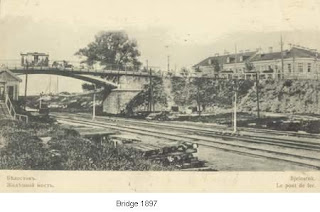Wednesday, 20 February 2008
The place where I live
Núria Iglesias Ferré
Tuesday, 19 February 2008
What do I do in the mornings.
Industrial design is one of my hobbies, that's why I never skip classes. We have learned to use AutoCAD and SolidWorks.
AutoCAD is a really powerful software as long as you draw in 2D. I prefer SolidWorks when drawing in 3D because this one is just amazing. It's hard to get use to it but when you do you can make possible whatever you have in mind. The best thing about it is how drawing works. First you just draw, it doesn't matter if the line isn't vertical nor horizontal, it doesn't even matter if the solid isn't long enough or if it's too short. You can always mend it, no matter how many things you have done over it.
I finish at 13:30 and I get home around 14:00.
Dani.
Białystok's History
The first mention of Białystok in written sources dates back to the year 1514. Around the year 1570 the Wiesiołowski family erected a fortress mansion within the limits of today’s city. In the 1670’s a wooden church was put up nearby and a market place was laid out, thus marking the beginning of what was to be an early town.
The Wiesiołowski fortress was destroyed during the Swedish invasion, to be reconstructed in the late 16th century by Stefan Mikołaj Branicki the Podlaskie Voivode, who converted it into a Baroque palace. It was then that Białystok began to look like a town, which was crowned by the city charter that was granted to Białystok in 1692 by king Jan III Sobieski, and confirmed by king August III the Saxon under the Magdeburg law in 1749. Białystok’s development owes much to the grand Crown Hetman and a claimant to the throne, Jan Klemens Branicki.
Following the year 1726, Branicki considerably extended the palace. He was the driving force of such undertakings as the establishing of a hospital, three schools, or a monastery. The Hetman and his wife were also recognized for their patronage of the arts and sciences.
In the aftermath of repressions in- flicted by the fall of the November Uprising, rigorous customs border measures were set up between the Congressional Kingdom of Poland and the Russian Tsar Empire. Paradoxically, the situation caused the city to flourish as many textile manufacturers moved to Białystok from the city of Łódź to escape high duties on goods exported to Russia. Consequently, the following years saw many manufacturing plants mushrooming in and around Białystok, thereby creating new jobs for the locals to reap the benefits of.
The city continued to develop following the launch of the Warsaw – Sankt Petersburg railway in 1862. By 1879 Białystok had as many as 47 textile factories of 1.500 employees, and the population almost numbered 35.000. The last decade of the 19th century saw telephone lines, water pipes and horse-pulled trams springing up. By the turn of the century the population reached 70.000.
Following the regaining of independence in 1919, Białystok became the capital of a newly formed voivodship and enlarged its territory by the incorporation of several suburban villages. In the late 1920’s and early 1930’s, the city centre was modernized and enriched with a newly landscaped metropolitan park dubbed Planty, to transform into an elegant office district.
Under the Nazi German occupation during World War II, in Białystok existed a strong resistance movement led by the National Army (Armia Krajowa). The Jewish population suffered the hardest moment when the Jews were relocated to a walled-in ghetto between July and August 1941 and then murdered or transported to camps in August 1943.
Sunday, 17 February 2008
Palau de la Música Catalana
 A hundred years ago was the first choral concert in this theatre. It's name means Catalonia's music palace. It was built with a public subscription and the architecture was a famous Modernist one. There are many ornaments with references to many composers and
A hundred years ago was the first choral concert in this theatre. It's name means Catalonia's music palace. It was built with a public subscription and the architecture was a famous Modernist one. There are many ornaments with references to many composers and  music goodness. There's a lovely stain glass work. At the beginning there were only choral concerts, made by volunteers but now choral singers are professional and many other singers use the place to give concerts.
music goodness. There's a lovely stain glass work. At the beginning there were only choral concerts, made by volunteers but now choral singers are professional and many other singers use the place to give concerts.







